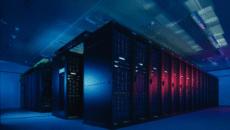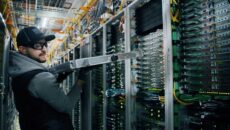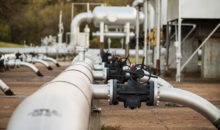Key Points
- Data centers are not the main driver of rising electricity costs. Research shows that infrastructure investments in aging grids, extreme weather protection, and maintenance are the primary contributors to rate hikes.
- Missouri is attracting major data center investments. Projects like Port KC’s $100 billion “Project Kestrel” and St. Louis-area hyperscale centers could generate billions in economic activity and long-term tax revenue.
- High-paying jobs and workforce development. These facilities are expected to create 50+ high-paying jobs per phase, with opportunities for local workforce training and career center investments.
- Hyperscale data centers support AI and digital services. Beyond AI, they enable telemedicine, e-commerce, and other essential digital infrastructure, with long-term benefits for local economies.
As electricity prices rise nationwide, up nearly 20 percent in some states over the past year, data centers have often been painted as energy villains. Critics argue these massive facilities, which power cloud computing, artificial intelligence, and digital services, strain local power grids and push costs onto everyday consumers.
But research and real-world experience suggest a more nuanced story. A new study from Lawrence Berkeley National Laboratory and the Brattle Group shows that increased electricity demand from data centers does not automatically translate into higher rates. Between 2019 and 2024, states that experienced spikes in data center energy consumption, including North Dakota and Virginia, actually saw lower average electricity costs.
“It’s contrary to what we’re seeing in the headlines today,” said Ryan Hledik to the Washington Post. Ryan serves as a principal at Brattle and a member of the research team. “This is a much more nuanced issue than just, ‘We have a new data center, so rates will go up.’”
Economic Benefits and High-Tech Jobs
Missouri has become a growing hub for data center development, particularly as artificial intelligence and cloud computing demand larger, hyperscale facilities. These centers represent billions in potential investment, high-paying jobs, and long-term technological growth for local economies.
For instance, Port KC’s proposed $100 billion “Project Kestrel” in Kansas City is set to create six hyperscale data centers spanning nearly 1.8 million square feet. Across all phases, the project is projected to generate more than $110 million in tax revenue, while creating roughly 50 high-paying jobs per phase with average salaries exceeding $100,000. The first payment of $2.62 million will fund the Northland Career Center, supporting workforce development programs that prepare residents for careers in the tech sector.
Similarly, St. Louis-area projects are drawing interest from major tech companies, including Meta, Google, and OpenAI. These developments promise high-paying construction jobs that extend over multiple years due to the continuous need for upgrades and maintenance. According to John Posey, director of research services for the East-West Gateway Council of Governments, “These facilities bring high-value jobs, long-term construction work, and opportunities for technological innovation that benefit Missouri’s communities.”
Addressing Community Concerns
Even with these benefits, some local officials and residents have voiced concerns. Critics worry about potential increases in electricity and water rates, particularly if utilities must expand generation or treatment facilities to accommodate new developments. Platte County Presiding Commissioner Scott Fricker has questioned whether subsidies to data centers might favor large corporations over local services and small businesses, asking, “Why were critical local resources completely ignored in favor of narrowly targeted benefits?”
In St. Louis, residents have raised questions about how new data centers might affect energy rates, given the city’s historically low electricity costs. Many are also curious whether the region currently has the capacity to meet the increased energy demand over the next five to ten years.
“It’s understandable that communities want to ensure residents are protected from rising utility costs,” Posey said. “At the same time, these concerns can often be addressed through smart planning, transparent incentives, and proactive investment in energy infrastructure.”
Hyperscale Data Centers and the AI Boom
Much of the recent expansion in Missouri is driven by artificial intelligence, which requires massive computational power and storage. Hyperscale data centers are designed to handle these demands efficiently. While some worry about the volatility of AI-driven growth, experts note that these facilities are built for the long term. They require ongoing upgrades and maintenance, supporting economic activity and technological advancement for decades.
According to Posey, “So much of the controversy revolves around hyperscalers because they are highly visible, but the demand for data centers is not just about AI, it’s about supporting all digital services that communities rely on, from telemedicine to e-commerce.”
Looking Beyond the Myths
Many concerns about data centers, such as the fear that they will skyrocket rates, stem from misunderstandings of how utility infrastructure works. While it’s true that these facilities use significant electricity, the bigger driver of rising rates is the aging grid itself. Utilities are investing billions in replacing poles, wires, transformers, and protective measures against extreme weather. Data centers, in many cases, contribute additional infrastructure investment rather than just increased demand.
For example, developers often build advanced cooling systems that use less water and electricity than older facilities, and their construction can bring local contractors, suppliers, and engineers new opportunities for work. With smart planning, data centers can serve as catalysts for energy efficiency upgrades in local grids, creating benefits for residential and commercial customers alike.
The Bottom Line
Data centers are not energy monsters, they are engines of economic growth, technological innovation, and workforce development. Missouri stands at a crossroads: by embracing these facilities and addressing community concerns with transparency, strategic planning, and infrastructure investment, the state can position itself as a hub for innovation, high-paying jobs, and sustainable economic growth, without leaving residents to shoulder unnecessary costs.
As debates continue in Jefferson City and local municipalities, it’s clear that data centers represent both an opportunity and a responsibility. The choice is whether Missouri will leverage these developments to strengthen communities or allow fear and misinformation to slow progress. With careful oversight, Missouri can have both a thriving data center industry and affordable, reliable electricity for all its residents.

Jake Kroesen is a Jackson County native and a graduate of the University of Central Missouri. He holds a B.S. in Political Science.












